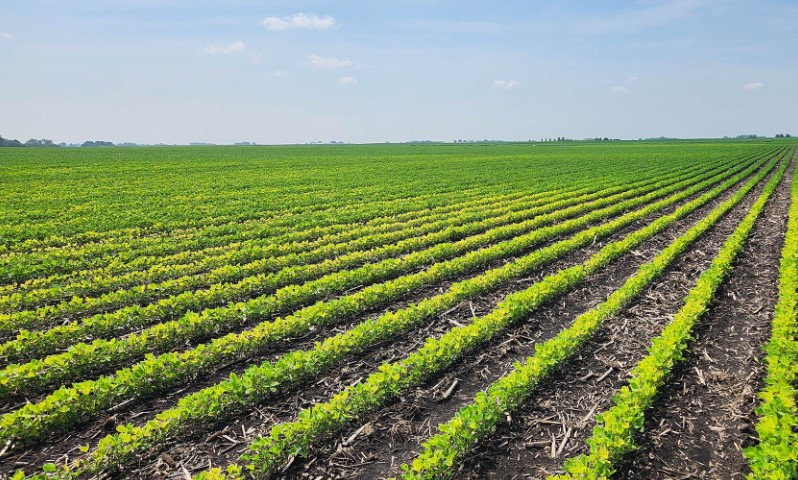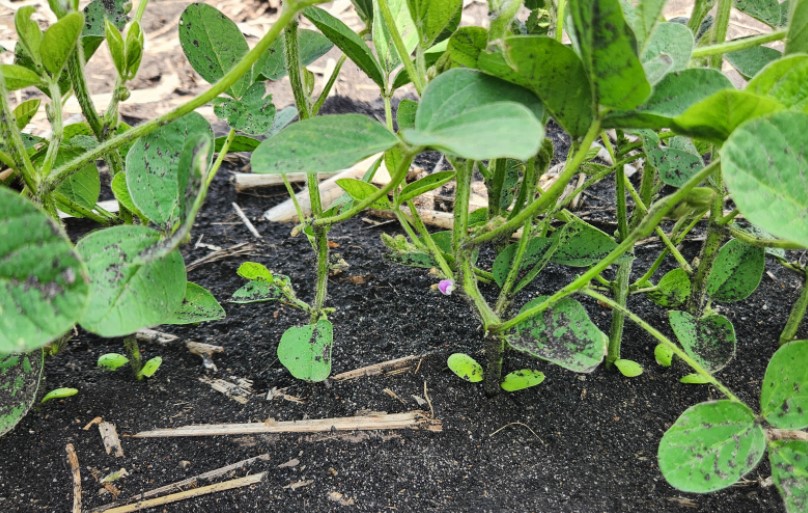
Iron deficiency chlorosis has been showing up in soybean fields. This disorder is not caused by a lack of iron in the soil, but rather the plant's inability to take up iron. (Photo: ISA/Alex Schaffer)
Walking Rows 2025: ISA agronomist update – June 19
June 19, 2025 | Kriss Nelson
Recent rain and warmer temperatures are proving ideal for soybean development. Iowa Soybean Association (ISA) agronomists are reporting that some soybean have flowered. They advise farmers to be aware of growth stages as they consider herbicide applications. Agronomists say farmers should continue to scout for pests, including soybean gall midge.
Alex Schaffer – Central/South Central Iowa
Things in central and south-central Iowa are really moving along now. Most of the first post-emergence herbicide application pass for both corn and soybeans is nearly complete at this point.
I have been seeing issues with waterhemp escaping the herbicide application. You can read more about my findings and advice by reading "Waterhemp escape highlights herbicide resistance challenges."

Some of the earliest-planted soybeans are approaching flowering. I heard my first reports of soybean flowers last Friday and saw my first set Monday. This is to be expected as we are approaching the longest day of the year (Friday, June 20). This is encouraging in terms of yield potential because the soybeans that are already flowering will take advantage of the long summer days while plants put energy into both vegetative growth and setting flowers at the nodes.

Corn is reaching the V8 growth stage and beyond, and is currently at a major milestone as the number of kernels around the ear will be determined at this point in the growing season. The rain and moderate heat are welcome as this will drive crop development, and adequate moisture will help make the ears girthier.
This is also when corn will enter the rapid growth stage, possibly putting on a new leaf every two days. As the corn crop gets taller, it will also become more susceptible to green snap. This is most likely to occur with strong winds early in the morning or late in the evening, when the plant's cells are at their maximum turgor pressure. This is when the cells are full of water and stretched to their maximum.
Iron Deficiency Chlorosis (IDC) is beginning to show up in some soybean fields. This disorder is not caused by a lack of iron in the soil, but rather the plant's inability to take up iron. This typically occurs on the Des Moines lobe under high pH conditions or in areas of the field where ponding has occurred, limiting the plant roots' ability to absorb nutrients.
ISA's Research Center for Farming Innovation is conducting a trial this year with two different IDC products, so be on the lookout for those results later this fall. The other control option for this problem is to select a soybean variety tolerant to IDC.
Shane Beck – Northeast/Northern Iowa
These last two weeks have given us some much-needed rain to help with crop growth, even though it has slowed down the sidedress applications of nitrogen and spraying in a lot of areas. Along with the heat this weekend, we should see good crop growth over the next few weeks. Last week we saw some hail in parts of north central Iowa. Some of the fields will be a complete loss, especially on the soybean side and some corn fields were significantly impacted.
Minor damage, including some torn leaves, was found in other areas. This damage leaves fields susceptible to diseases, particularly bacterial diseases.

We are also starting to see some Iron Deficiency Chlorosis (IDC) show up in central and north central Iowa, especially on the earlier planted soybeans. IDC is the deficiency of iron in the plant. Even though there is sufficient iron in the soil for the plant, it is not taken up by the plant sufficiently. IDC is typically found in high pH areas of the field and usually in spots that do not drain as well as other parts. There is not much that a person can do about it once it shows up in the field. An application of chelated iron with the sprayer is a possibility, but the plants will usually grow out of the deficiency in a few weeks.
Iowa State University has sent out a couple of notifications this week about insect pests, including soybean gall midge. This is the time of year that soybean gall midge typically infect plants. The pests normally infest a field starting on the field edge, so that’s the place to start scouting your fields. For now, this pest is typically limited to the western area of the state. Counties west of Interstate 35 should be especially vigilant regarding soybean gall midge.
The other ISU alert was regarding corn rootworm. Although we are still a few weeks to a month away from the corn rootworm beetle trapping timing, ISU is looking for volunteers to join the corn rootworm trapping network. They will provide traps and a set of instructions on how to place the traps and record the number of beetles present. If you are interested in participating, send your contact information to bugtraps@iastate.edu.
Mikaela Connelly – Southwest/West Central Iowa
The crops have looked great the past couple of weeks. I’ve seen V5/V6 staged soybeans and V11 corn, so the crops are loving the warm weather and moisture we’ve gotten recently. I’m hoping parts of districts 4 and 7 can get some rain this week as well.
I’ve seen some flowers developing on soybeans, which is exciting to think the crops are already working on determining seeds per pod and rows of kernels. I caution everyone to stage your crops prior to doing herbicide passes because I have seen some herbicide injury on soybeans.

Now is the time to be on the lookout for soybean gall midge. Other pests that I have spotted – though not in a large significance – include green stink bugs and a variety of caterpillars.
I have also heard of tar spot making its appearance in Iowa, so be sure to start scouting your fields for diseases as fungicide season quickly approaches.
Craig Woods – Northwest Iowa
Crop growth is progressing nicely, with soybeans at the V3-V4 growth stage and corn at the V4-V6 stage, thanks to ample moisture and heat units.
To have moisture, there must be storms. Unfortunately, on June 11, a large storm brought hail damage to a portion of Palo Alto County. In addition to some hail damage, there are areas that received some ponding and potentially some washout because of spotty heavy precipitation. For fields that received damage from wind or hail, it will be important to monitor and scout for diseases due to possible open wounds allowing for infection.

Sprayers were rolling, trying to apply post-emergence herbicides to control weeds that were growing at an increased rate alongside the crop before the canopy had a chance to close. During my scouting, I discovered some minor herbicide injury. While not enough to significantly impact yield, it serves as a reminder to be mindful of potential drift from unfavorable weather.
On the pest front, soybeans are reaching the stage where gall midge will start looking to infect field edges and begin larval feeding.
For corn, assessing corn rootworm pressure in the coming weeks will allow for future management decisions to be made effectively.
Evan Brehm – Southeast/Eastern Iowa
Soybeans have rallied from the warmer temperatures and are taking advantage of the sunlight prior to the summer solstice. I haven’t seen flowering yet, but some early-planted soybeans are at the V6 stage or greater.
Early planted corn has reached the “knee high before the Fourth of July” stage. Replanted acres are nearing V6 growth stage and taking advantage of more warm days and sunlight, but needing moisture.
Small grains are in late flowering stages. Looking at a wheat field in Benton County and a rye field in Buchanan County, both of which will harvest these small grains, the harvest is predicted to occur within the next three weeks. We hope to not have strong winds as the small grain stems are fragile, pushing all their energy into ripening the grain.

Japanese beetles are a statewide issue, but urban legend has it they started in eastern Iowa. With some digging of roots in fields, we’re finding grubs, which will emerge as beetles. Careful inspection allows a person to figure out what beetle it is by the hairs on the rear end. June bugs and Japanese beetles are the general culprits. Be on the lookout for Japanese beetles in both soybeans and corn acres in the next month.
Second pass herbicide applications in soybean acres for herbicide and any weed escapes in corn are being completed.
There is no doubt cover crops have assisted in weed suppression; however, continue to scout those soybean acres and decide if a post-emergence herbicide application is necessary. With corn canopy closure covering rows, penetration of the chemicals can be an issue.
In the last edition of Walking Rows, I discussed an ugly situation of soybeans planted on April 15 into a living cover crop. The good news is that it is no longer an ugly situation. These early “planted green” soybean acres are now benefiting from the warmer temperatures and recent rain showers.
Later “planted green” soybean acres have not had issues as the temperatures have been more consistent. If you’ve questioned this method of planting soybeans into a living cover crop, be sure to check out some field sights in District 6 where we have a Conservation in Action tour.
These fields will give you confidence this planting method can be done.
With the recent wildfires, producers are inquiring about what affect it could have on crop yields. In my research I found an informative article from Pioneer, “Is Smoke from Wildfires Affecting Crop Yields? | Pioneer® Seeds.”
The article discusses how plants require sunlight to produce photosynthesis. Photosynthesis drives production that ends in yield. Wildfire smoke has increased in recent years and is expected to remain a persistent presence. It does reduce air quality, but at a macro level of reducing crop yields that has not been confirmed. Studies show reducing yield would require 30% less sunlight or greater, which wildfires do not do.
This can also vary from field to field, with plant population and hybrids. Plants also respond to their situations. It has been noted that corn and soybeans can benefit from less sunlight as they enter a protective mode and conserve energy. However, long-term, this can cause weak stalks, especially in corn plants.
Written by Kriss Nelson.
Back